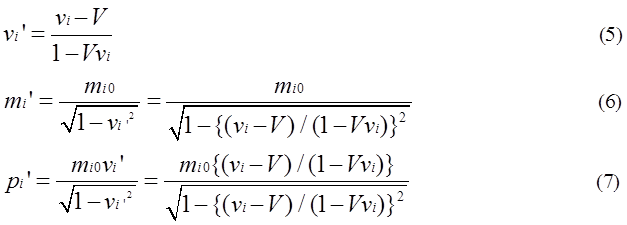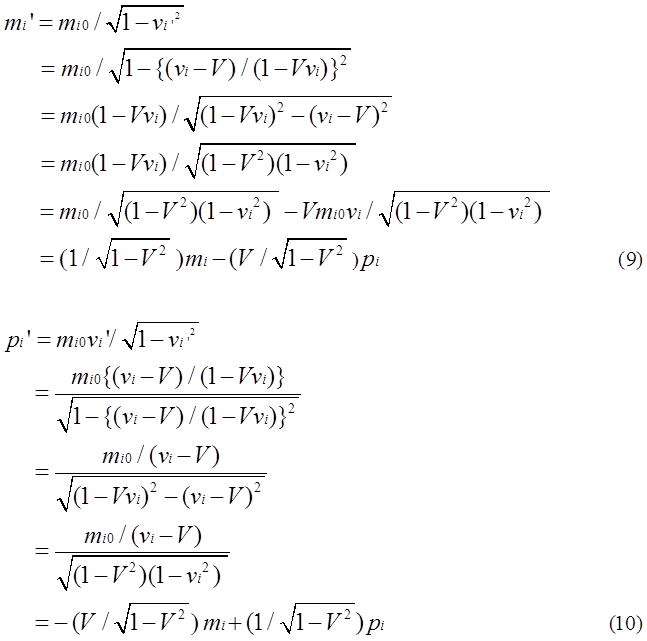


m0 is a rest mass and v is the velocity of the center of a rest mass in a coordinate A. v is defined as non-dimensional velocity divided by light speed.Equation(1),(2) are important to express that m has kinetic energy and rest energy m0. In addition, m0 is transformed into m according to Lorentz transformation. However, there remains a basic question about what is rest energy. When we observe a moving mass m at the same velocity v, m0 is stationary. Even if the center of rest mass system is resting, it should be considered that inner part of rest mass is not resting.
To
make it clear what is rest mass, it is possible to suppose that a
lot of mass are moving in a coordinate A as shown in Fig.2. Among a
group, mi
is a mass and vi is the velocity of mass in the preceding coordinate
A.


A group of mass is observed from a different coordinate B. Coordinate B is moving with velocity V in the coordinate A. There is always a coordinate where a group of mass is considered to be stationary. According to the formula of synthesis of velocity, vi is converted into vi’ in the coordinate B. Velocity vi’ is expressed by equation (5). Using equation (5), mi’ and pi’ are expressed by equation (6),(7).


The sum of mi
and pi are expressed by following equations.
A group of mass and momentum are defined as following.These equations mean
that mass M(total energy) is the
summation of relativistic mass mi and P(total of momentum) is summation of momentum pi.
meaning respectively.
Equations (11), (12) are expressed by a matrix equation.


Conclusion
Mathematical
analysis concerning a group of rest mass and momentum helps to understand the
concept of rest mass.
<Postscript>
 which is attributed to electromagnetic field energy.
which is attributed to electromagnetic field energy.1 Gary Oas, On the abuse and use of relativistic mass, physics.ed-ph 21 Oct 2005 p1-2
2 LL. B. Okun (1989), "The Concept of Mass", Physics Today 42 (6): p31–36
4 http://en.wikipedia.org/wiki/Mass_in_special_relativity
Translation of the article into Japanese.
静止質量とは何か? 簡潔な解析による質量集団が静止質量と運動エネルギを持つことの証明
宮地宣夫による 翻訳 2012年7月9日
序言
多くの人々は特殊相対論の静止質量の概念について混乱している。科学者達も静止質量について考察してきた。
(Gary Oas1, L. B. Okun2 , Max Jammer 3)一個の静止質量は静止エネルギと等価であると考えられてきた。というのは相対論的
質量の式をテーラー展開すると静止質量と運動エネルギに分離できるからである。
しかし、式の展開後も、静止質量とは何かの問題は残る。この記事は静止質量の概念を示すことが目的である。各々の質点が
任意の速度で動く質量集団もまた等価的な静止質量をもっている。質量集団の質量と運動量はローレンツ変換のベクトル
として定義できる。(ここでは時間軸とX軸のみ)この考え方を発展させて、一個の静止質量はより小さい静止質量に分解できる。
(見かけは静止していても、止まっている質量でなく運動する質量に分解できる。)
更に、その小さい静止質量も繰り返してより小さい質量に分解できる。一個の静止質量は閉じ込められた運動エネルギを含む。
つまり、内部の閉じ込められた運動エネルギは静止エネルギの成分である。
例として、止まっている物体は、熱によって分子運動する無数の分子で構成されている。この閉じ込められた運動エネルギは静止
エネルギの一部である。
光子を考えると、光子を止まって見ることはできない。光速は最大速度であるからだ。光子エネルギはすべて運動量であって静止
エネルギではない。光子以外の物体は、それを追跡して、静止しているのを見ることができる。この場合、物体の位置が動かないの
で、巨視的な運動量はゼロであると言える。しかし、静止質量は内部の微視的世界で運動量を持つことを覚えておく必要がある。
内部の運動量の合計がゼロならば、観測者の静止系でその物体が静止していると見なされるのである。この考えに従えば、言葉
でなく、数学的解析を使って静止質量は運動エネルギをもつことが証明される。
質量集団のモデル化
最初に、ある慣性座標系Aで図1に示す単一の質量が速度Vで動くことを想定する。相対論的質量は有名な式(1)で示される。
(wikipedia.org/wiki/Mass in special relativity4)
運動量pを含めると、質量mと運動量pはローレンツ変換の行列の式(2)で示される。


m0は静止質量、vは静止質量の中心(運動量pの中心)の速度である。ここでの速度は光速で割った無次元速度である。
式(1)、(2)は重要で、mは運動エネルギと静止エネルギm0を持っていることを示す。さらに、(m0、0)はローレンツ変換により
(m、p)に変換される。(vの速度をもつ移動座標系ではm=m0、p=0)
しかし、一個の質量のみ考えていると、静止質量とは何かという基本的問題は残されている。一個の質量を同じ速度vで観察する
と、m0は静止している。たとえ静止質量中心が止まっていても、質量の内部は静止していないとすべきである。
静止質量とは何かを明らかにするために、図2に示されるように、多数の運動する質量を想定することができる。
図2の集団の中で、miは質量で、viは前述した座標系Aにおける速度である。

ローレンツ変換の一般化された応用
個々の質量と運動量は座標系Aで以下の式で示される。これは、式(1)、(2)と同様である。
質量集団は違った座標系Bでも観測できる。座標系Bは慣性系Aに対して一定速度Vで移動する座標系とする。いつも必ず質量
集団が静止していると見なすことができる特別な座標系が存在する。式(3)、(4)を特殊相対論の速度合成の公式に従ってviを
座標系Bの速度vi’に変換すると式(5)となる。式(5)を使って、座標系Bにおける質量mi’と運動量pi’は式(6)、(7)で示される。

式(8)は常に成り立つ。(以外かもしれないが検算すれば確かでである。)
式(3)、(4)、(8)を式(6)、(7)に代入すると式(9)、(10)が得られる。

miとpiについて総和をとると式(11)、(12)が得られる。


集団の質量Mと運動量Pは次のように定義できる。これら式は質量M(全エネルギ)は相対論的質量の和であり、P(運動量)は
運動量piの総和であることを意味する。M’ とP’の式も同様の意味を持っている。
式(11)、(12)は行列の式で表される

P=MVの式を参照すれば、M’は等価的な静止質量M0とみなせる。M0は相対論的質量mi'の総和である。この場合、
相対論的質量は質量集団の静止質量を定義する上で重要である。

式(6)、(13)から等価的静止質量M’は、mi0の合計値よりも大きい。各々のmiが速度viで動くと仮定した事実にかかわらず、
特別な座標系Bでは運動量の総和はP’=0となるので、M’は静止している質量とみなされる。
式(18)は一個の質量は不変量を持つことを示す有名な式である。式(19)もまた集団の質量Mは不変量を持つことを示す。
集団が(外力によってばらばらにならないで)、M0内に閉じ込められている限り、Mはどんな慣性系についても不変量M0を持つ。

結論
質量集団の静止質量と運動量の数学的解析は静止質量の概念を理解する上で役立つ。
1)質量と運動量の集団はローレンツ変換のベクトルとして定義できる。さらに、集団の速度は計算でき、集団の代表速度で動く
座標系ではゼロになる。
2)等価的静止質量M0は内部静止質量よりも大きい。それは、運動エネルギが静止質量M0の成分であることを意味する。
3)一個の静止質量は繰り返し分解操作を実行すれば、小さい質量へと無限に分解される可能性がある。
後書
極端な場合を想定することが出来る。最小の静止質量は、ある座標系で2個の対称な運動量をもつ光子で構成されている可能
性がある。静止質量の起源は電磁場の光子のエネルギかもしれない。
1 Gary Oas, On the abuse and use of relativistic mass, physics.ed-ph 21 Oct 2005 p1-2
2 LL. B. Okun (1989), "The Concept of Mass", Physics Today 42 (6): p31–36